Agriculture in Marginal Areas: Reintroduction of Rye and Wheat Varieties for Breadmaking in the Antrona Valley
Abstract
1. Introduction
2. Materials and Methods
2.1. Plant Material
2.2. Experimental Design
2.3. Agronomic Parameters
2.4. Compositional Analysis
2.5. Mixing and Leavening Properties
2.6. Breadmaking and Characterisation
2.7. Mycotoxin Analysis
2.8. Statistical Analysis
3. Results
3.1. Comparison of Wheat Varieties over Two Years: Agronomic Aspects
3.2. Comparison of Rye Varieties over Two Years: Agronomic Aspects
3.3. Compositional Analyses of Flours
3.4. Dough and Bread Characteristics
3.5. Mycotoxin Analysis
4. Discussion
Supplementary Materials
Author Contributions
Funding
Data Availability Statement
Acknowledgments
Conflicts of Interest
References
- Hammer, K.; Xhuveli, L.; Perrino, P. Estimating genetic erosion in landraces? two case studies. Genet. Resour. Crop Evol. 1996, 43, 329–336. [Google Scholar] [CrossRef]
- FAO. Agricultural Biodiversity. Background Paper 1. FAO/Netherlands Conference of Multifunctional Character of Agriculture and Land. 1999. Available online: http://www.fao.org/mfcal/pdf/bp_1_agb.pdf (accessed on 1 May 2022).
- FAO. Building on Gender, Agrobiodiversity and Local Knowledge; Food and Agriculture Organization of the United Nations: Rome, Italy, 2004; Available online: http://www.fao.org/docrep/007/y5609e/y5609e00.htm (accessed on 1 May 2022).
- FAO. Second Report on the State of the World’s Plant Genetic Resources for Food and Agriculture; Commission on Genetic Resources for Food and Agriculture, Food and Agriculture Organization of the United Nations: Rome, Italy, 2010. [Google Scholar]
- Esquinas-Alcázar, J. Protecting crop genetic diversity for food security: Political, ethical and technical challenges. Nat. Rev. Genet. 2005, 6, 946–953. [Google Scholar] [CrossRef] [PubMed]
- Jackson, L.; Pascual, U.; Hodgkin, T. Utilizing and conserving agrobiodiversity in agricultural landscapes. Agric. Ecosyst. Environ. 2007, 121, 196–210. [Google Scholar] [CrossRef]
- Giupponi, L.; Pilu, R.; Scarafoni, A.; Giorgi, A. Plant agro-biodiversity needs protection, study and promotion: Results of research conducted in Lombardy region (Northern Italy). Biodivers. Conserv. 2020, 29, 409–430. [Google Scholar] [CrossRef]
- Sangiorgio, S.; Colombo, F.; Ghidoli, M.; Giupponi, L.; Ferro, G.; Ferro, C.G.; Cassani, E.; Landoni, M.; Pilu, R. The Ancient Varieties of Mountain Maize: The Inheritance of the Pointed Character and Its Effect on the Natural Drying Process. Agronomy 2021, 11, 2295. [Google Scholar] [CrossRef]
- Jones, H.; Lister, D.L.; Bower, M.A.; Leigh, F.J.; Smith, L.M.; Jones, M.K. Approaches and constraints of using existing landrace and extant plant material to understand agricultural spread in prehistory. Plant Genet. Resour. 2008, 6, 98–112. [Google Scholar] [CrossRef]
- Zeven, A.C. Traditional maintenance breeding of landraces: 2 Practical and theoretical considerations on maintenance of variation of landraces by farmers and gardeners. Euphytica 2002, 123, 147–158. [Google Scholar] [CrossRef]
- Camacho Villa, T.C.; Maxted, N.; Scholten, M.; Ford-Lloyd, B. Defining and identifying crop landraces. Plant Genet. Res. 2005, 3, 373–384. [Google Scholar] [CrossRef]
- Aguiriano, E.; Ruiz, M.; Fité, R.; Carrillo, J.M. Analysis of genetic variability in a sample of the durum wheat (Triticum durum Desf.) Spanish collection based on gliadin markers. Genet. Resour. Crop Evol. 2006, 53, 1543–1552. [Google Scholar] [CrossRef][Green Version]
- Teklu, Y.; Hammer, K.; Huang, X.Q.; Roder, M.S. Analysis of microsatellite diversity in Ethiopian tetraploid wheat landraces. Genet. Resour. Crop Evol. 2005, 53, 1115–1126. [Google Scholar] [CrossRef]
- Brandolini, A. Maize introduction, evolution and diffusion in Italy. Maydica 2009, 54, 233–242. [Google Scholar]
- de Carvalho, M.A.; Bebeli, P.J.; Bettencourt, E.; Costa, G.; Dias, S.; Dos Santos, T.M.; Slaski, J.J. Cereal landraces genetic resources in worldwide GeneBanks. A review. Agron. Sustain. Dev. 2013, 33, 177–203. [Google Scholar] [CrossRef]
- Cantaluppi, E.; Manzi, S.; Egal, A.A.; Puglisi, D.; Cassani, E.; Toschi, I.; Cesari, V.T.; Landoni, M.; Scapin, A.; Pilu, S. Nutritional and phenotypical characterization of two South African maize (Zea mays L.) varieties sampled in the Qwa-Qwa region. Maydica 2017, 62, 1–10. [Google Scholar]
- Landoni, M.V.; Andrea, S.; Cassani, E.; Borlini, G.; Follador, A.R.V.; Giupponi, L.; Ghidoli, M.; Hejna, M.; Rossi, L.; Pilu, S.R. Comparison among four maize varieties in conventional and low input cultivation. Maydica 2020, 65, 1–13. [Google Scholar]
- Giupponi, L.; Leoni, V.; Colombo, F.; Cassani, E.; Hejna, M.; Rossi, L.; Pilu, R. Characterization of “Mais delle Fiorine” (Zea mays L.) and nutritional, morphometric and genetic comparison with other maize landraces of Lombardy region (Northern Italy). Genet. Resour. Crop Evol. 2021, 68, 2075–2091. [Google Scholar] [CrossRef]
- Tesemma, T.; Tsegaye, S.; Belay, G.; Bechere, E.; Mitiku, D. Stability of performance of tetraploid wheat landraces in the Ethiopian highland. Euphytica 1998, 102, 301–308. [Google Scholar] [CrossRef]
- Pinheiro de Carvalho, M.A.A.; Slaski, J.J.; dos Santos, T.M.M.; Ganança, F.T.; Abreu, I.; Taylor, G.J.; Clemente Vieira, M.R.; Popova, T.N.; Franco, E. Identification of aluminium resistant genotypes among Madeiran regional wheats. Commun. Soil Sci. Plant Anal. 2003, 34, 2973–2985. [Google Scholar] [CrossRef]
- Newton, A.C.; Akar, T.; Baresel, J.P.; Bebeli, P.J.; Bettencourt, E.; Bladenopoulos, K.V.; Czembor, J.H.; Fasoula, D.A.; Katsiotis, A.; Koutis, K.; et al. Cereal landraces for sustainable agriculture. A review. Agron. Sust. Dev. 2010, 30, 237–269. [Google Scholar] [CrossRef]
- Ceccarelli, S.; Grando, S. Decentralized-participatory plant breeding: An example of demand driven research. Euphytica 2007, 155, 349–360. [Google Scholar] [CrossRef]
- Mulac, D.; Hans-Ulrich, H. Cytotoxicity and Accumulation of Ergot Alkaloids in Human Primary Cells. Toxicology 2011, 282, 112–121. [Google Scholar] [CrossRef]
- AOAC. Official Methods of Analysis of the Association of Official Analytical Chemists: Official Methods of Analysis of AOAC International, 21st ed.; AOAC: Washington, DC, USA, 2019. [Google Scholar]
- American Oil Chemistry Society (AOCS). Crude Fiber Analysis in Feeds by Filter Bag Technique. Official Methods and Recommended Practices; YUMPU Publishing: Champaign, IL, USA, 2009. [Google Scholar]
- ICC. Standard methods. International Association for Cereal Science and Technology; ICC: Vienna, Austria, 1992. [Google Scholar]
- American Association of Cereal Chemists (AACC). Approved Methods of Analysis, 11th ed.; American Association of Cereal Chemists (AACC): St. Paul, MN, USA, 2001. [Google Scholar]
- EN 17280:2019; Foodstuffs—Determination of Zearalenone and Trichothecenes Including Deoxynivalenol and Its Acetylated Derivatives (3-Acetyl-deoxynivalenol and 15-Acetyl-deoxynivalenol), Nivalenol T-2 Toxin and HT-2 Toxin in Cereals and Cereal Products by LC-MS/MS; European Committee for Standardization: Brussels, Belgium, 2019.
- Debegnach, F.; Patriarca, S.; Brera, C.; Gregori, E.; Sonego, E.; Moracci, G.; De Santis, B. Ergot alkaloids in wheat and rye derived products in Italy. Foods 2019, 8, 150. [Google Scholar] [CrossRef] [PubMed]
- Svingen, T.; Lund Hansen, N.; Taxvig, C.; Vinggaard, A.M.; Jensen, U.; Have Rasmussen, P. Enniatin B and beauvericin are common in Danish cereals and show high hepatotoxicity on a high-content imaging platform. Environ. Toxicol. 2017, 32, 1658–1664. [Google Scholar] [CrossRef] [PubMed]
- Babič, J.; Tavčar-Kalcher, G.; Celar, F.A.; Kos, K.; Knific, T.; Jakovac-Strajn, B. Occurrence of Alternaria and other toxins in cereal grains intended for animal feeding collected in Slovenia: A three-year study. Toxins 2021, 13, 304. [Google Scholar] [CrossRef] [PubMed]
- Rossi, G.; Guzzon, F.; Bickler, C.; Cauzzi, P.; Di Martino, L.; Di Cecco, V.; Domina, G.; Gargano, D.; Vagge, I.; Orsenigo, S.; et al. Seed germination under osmotic stress across different wild populations of mountain rye (Secale strictum (C.Presl) C.Presl). Plant Biosyst. 2022, 15, 345–352. [Google Scholar] [CrossRef]
- Harlan, H.V.; Martini, M.L. A composite hybrid mixture. J. Amer. Soc. Agron. 1929, 21, 487–490. [Google Scholar] [CrossRef]
- Goldringer, I.; Prouin, C.; Rousset, M.; Galic, N.; Bonnin, I. Rapid differentiation of experimental populations of wheat for heading time in response to local climatic conditions. Ann. Bot. 2006, 98, 805–817. [Google Scholar] [CrossRef]
- Raggi, L.; Ciancaleoni, S.; Torricelli, R.; Terzi, V.; Ceccarelli, S.; Negri, V. Evolutionary breeding for sustainable agriculture: Selection and multi-environment evaluation of barley populations and lines. Field Crop. Res. 2017, 204, 76–88. [Google Scholar] [CrossRef]
- Suneson, C.A. An evolutionary plant breeding method. Agron. J. 1956, 48, 188–191. [Google Scholar] [CrossRef]
- Rasmusson, D.C.; Beard, B.H.; Johnson, F.K. Effect of natural selection on performance of a barley population. Crop Sci. 1967, 7, 543. [Google Scholar] [CrossRef]
- Allard, R.W. Relationship between genetic diversity and consistency of performance in different environments. Crop Sci. 1961, 1, 127–133. [Google Scholar] [CrossRef]
- Döring, T.F.; Annicchiarico, P.; Clarke, S.; Haigh, Z.; Jones, H.E.; Pearce, H.; Snape, J.; Zhang, J.; Wolfe, M.S. Comparative analysis of performance and stability among composite cross populations, variety mixtures and pure lines of winter wheat in organic and conventional cropping systems. Field Crop. Res. 2015, 183, 235–245. [Google Scholar] [CrossRef]
- Reiss, E.R.; Drinkwater, L.E. Cultivar mixtures: A meta-analysis of the effect of intraspecific diversity on crop yield. Ecol. Appl. 2018, 28, 62–77. [Google Scholar] [CrossRef] [PubMed]
- Wolfe, M.S.; Brändle, U.; Koller, B.; Limpert, E.; McDermott, J.M.; Müller, K.; Schaffner, D. Barley mildew in Europe: Population biology and host resistance. Euphytica 1992, 63, 125–139. [Google Scholar] [CrossRef]
- Smithson, J.B.; Lenné, J.M. Varietal mixtures: A viable strategy for sustainable productivity in subsistence agriculture. Ann. Appl. Biol. 1996, 128, 127–158. [Google Scholar] [CrossRef]
- Mundt, C.C. Use of multiline cultivars and cultivar mixtures for disease management. Annu. Rev. Phytopathol. 2002, 40, 381–410. [Google Scholar] [CrossRef] [PubMed]
- Patel, J.D.; Reinbergs, E.; Mather, D.E.; Choo, T.M.; Sterling, J.D. Natural selection in a double-haploid mixture and a composite cross of barley. Crop Sci. 1987, 27, 474–479. [Google Scholar] [CrossRef]
- Van Wart, J.; van Bussel, L.; Wolf, J.; Licker, R.; Grassini, P.; Nelson, A.; Boogaard, H.; Gerber, J.; Muller, N.; Claessens, L.; et al. Use of agro-climatic zones to upscale simulated crop yield potential. Field Crop. Res. 2013, 143, 44–55. [Google Scholar] [CrossRef]
- Bushuk, W. Rye: Production, Chemistry, and Technology, 2nd ed.; American Association of Cereal Chemists: St. Paul, MN, USA, 2001. [Google Scholar]
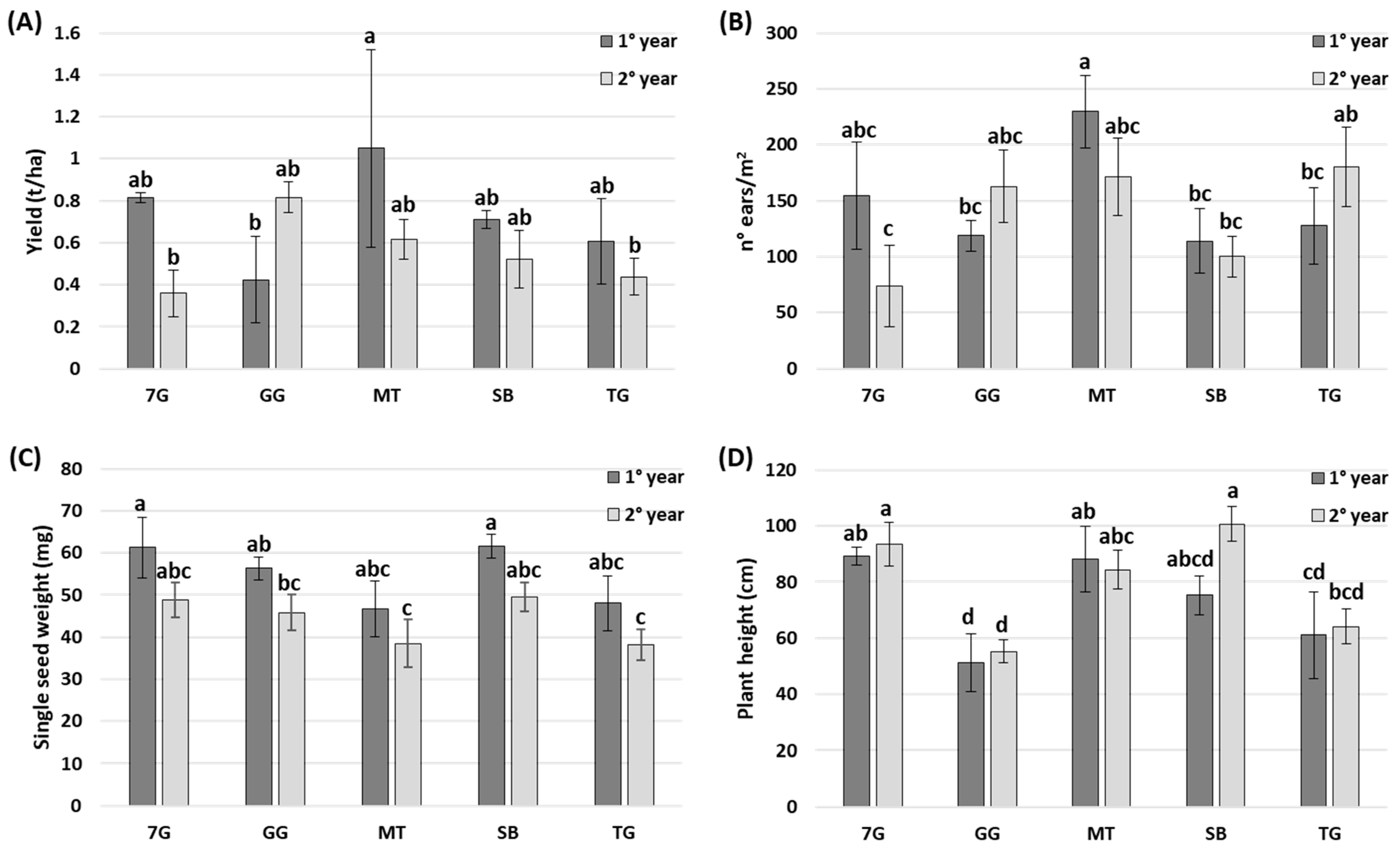
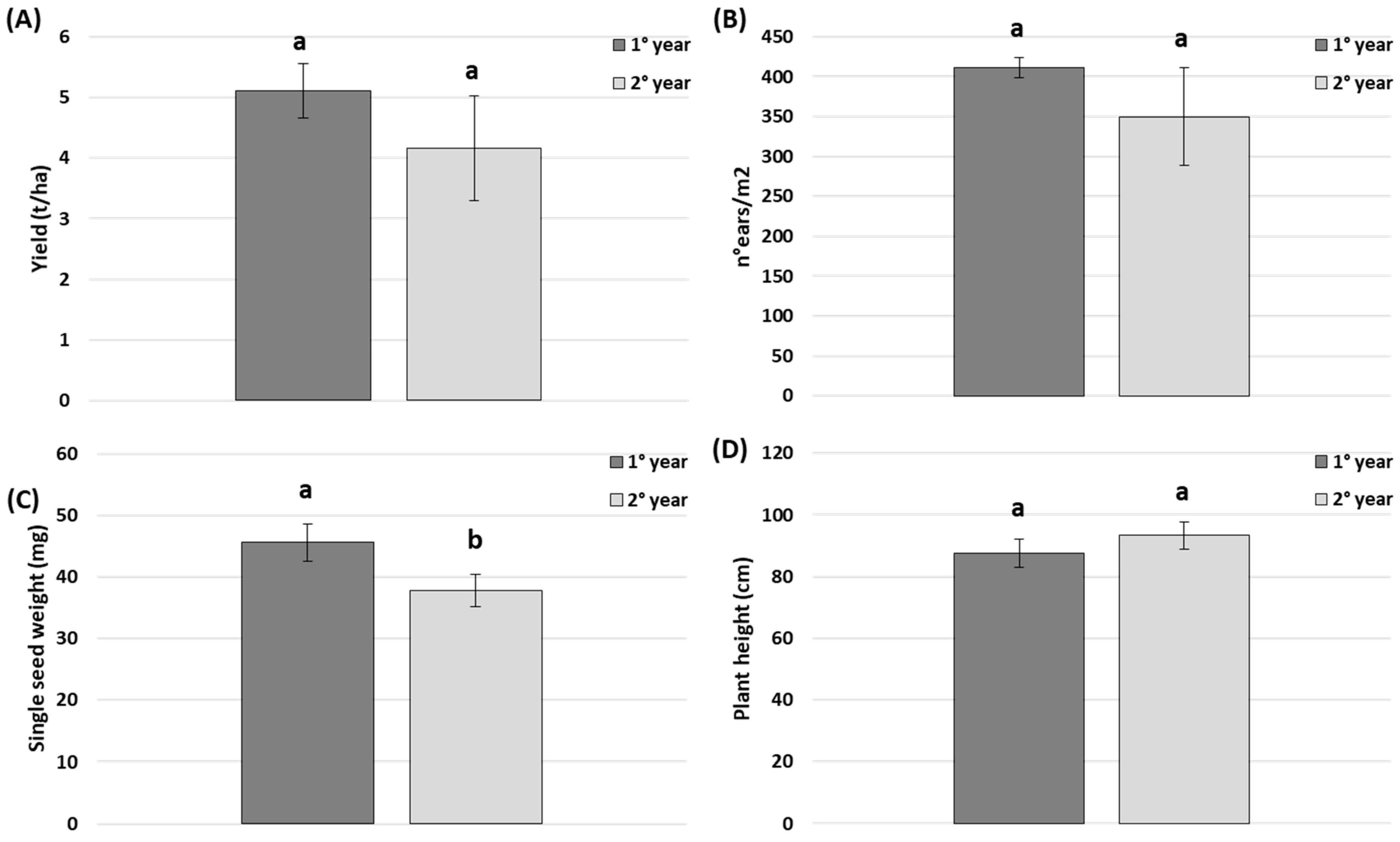
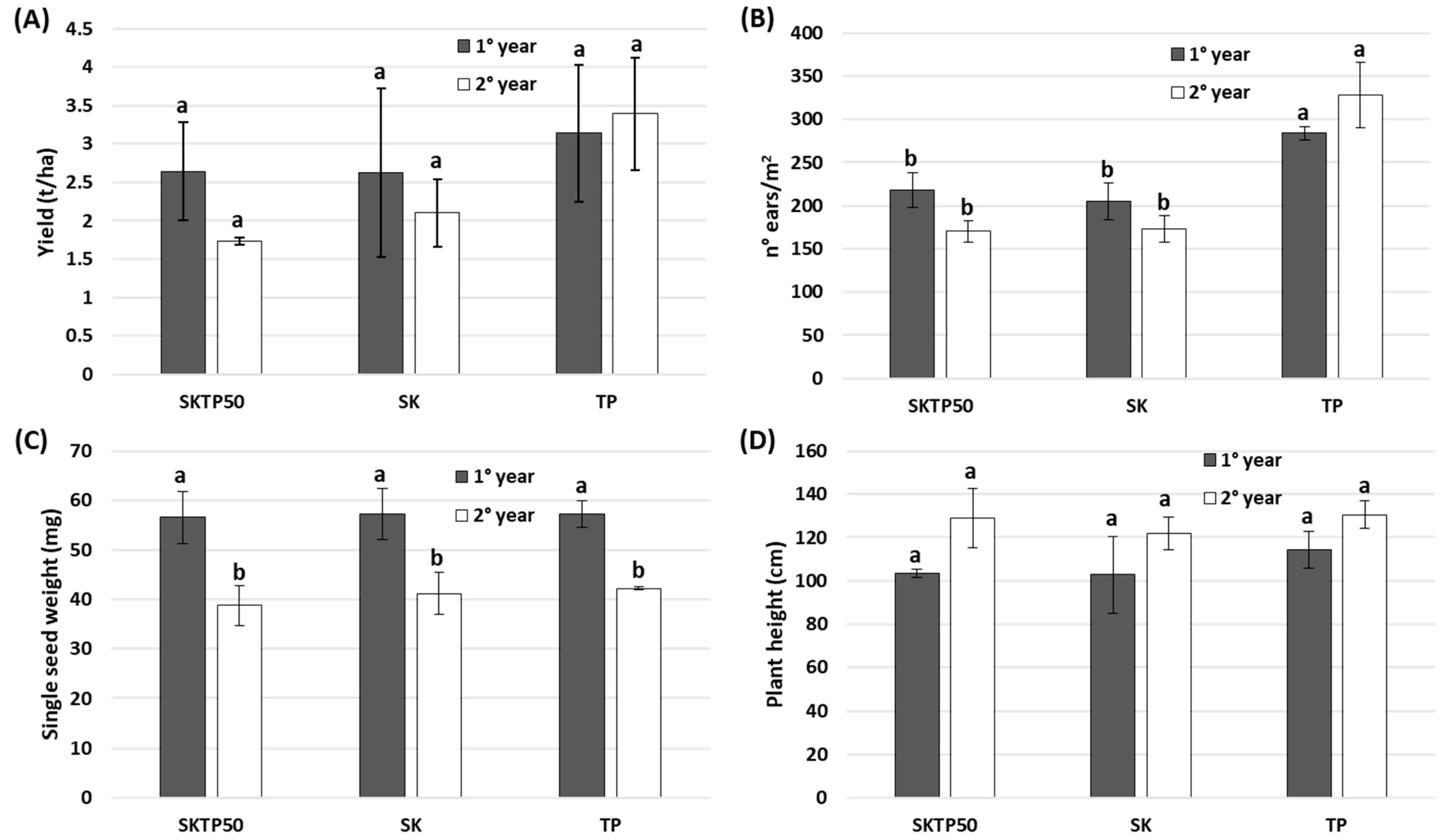
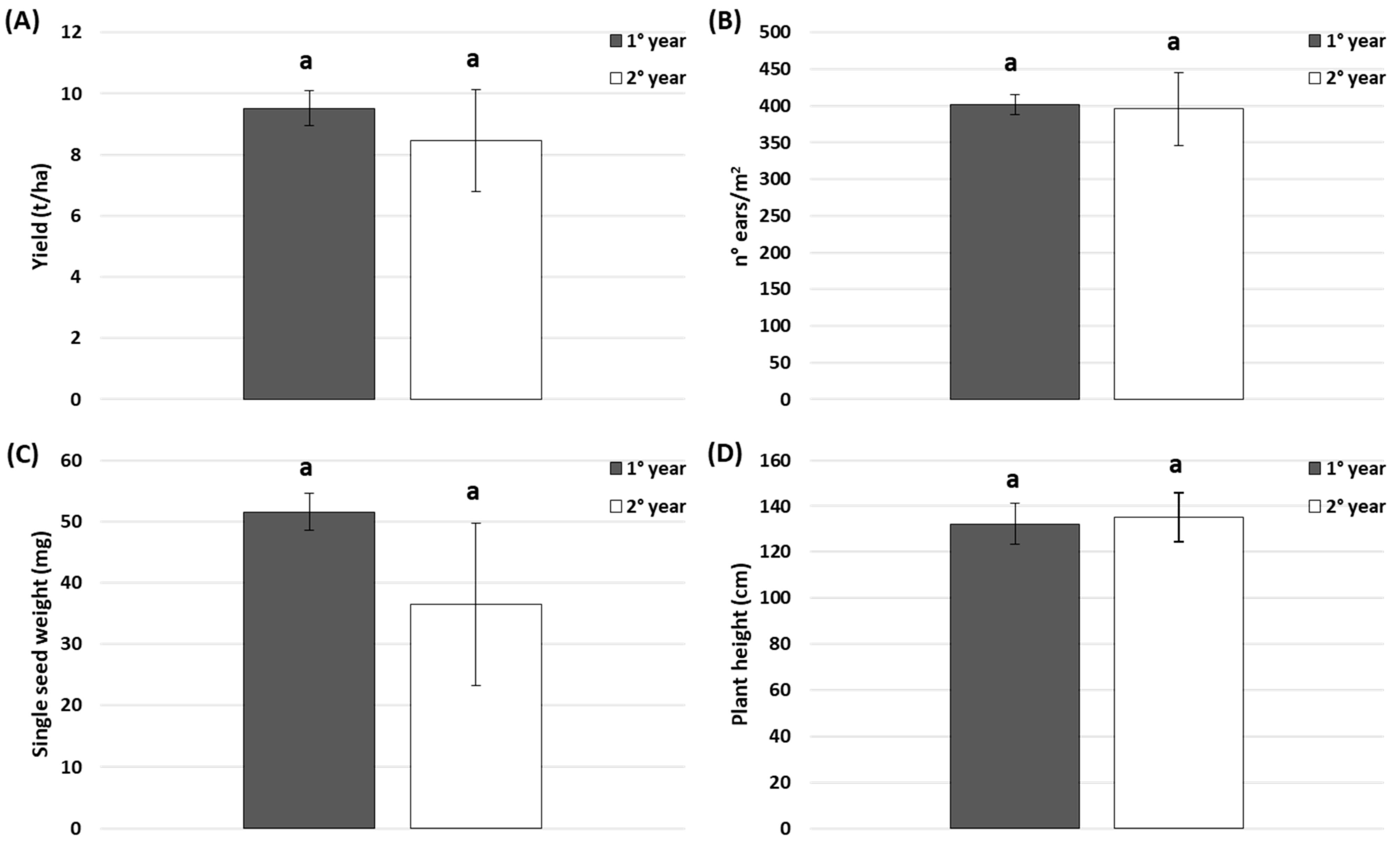

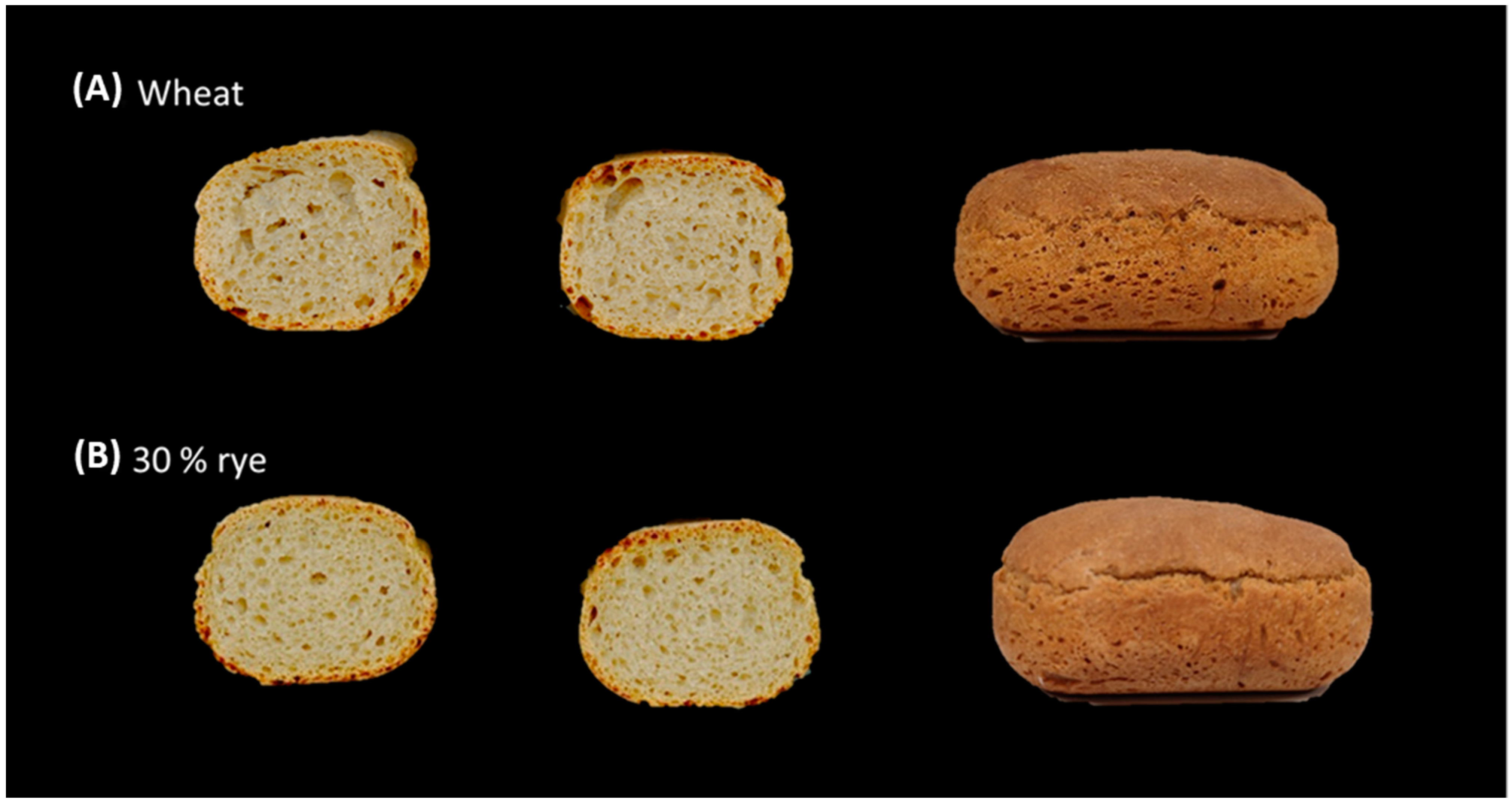
| Crop | Variety | Abbreviation | Typology | Experimental Field |
|---|---|---|---|---|
| Wheat | 7 Grani * | 7G | Mix | Varchignoli |
| Giorgione | GG | Traditional variety | ||
| Mentana | MT | Traditional variety | ||
| Solibam | SB | Evolutionary population | ||
| Tengri | TG | Modern variety | ||
| San Pastore | SP | Traditional variety | Valleggia | |
| Rye | SKTP50 ** | SKTP50 | Mix | Varchignoli |
| Stanko | SK | Modern variety | ||
| Tradizionale Piemonte | TP | Traditional variety | ||
| Alpina | AP | Traditional variety | Valleggia |
| Variety | Ash (%) | Crude Fibre (%) | Crude Fat (%) | Crude Protein (%) | Starch (%) |
|---|---|---|---|---|---|
| 7G | 2.07 ± 0.05 a | 1.95 ± 0.01 b | 1.06 ± 0.04 bc | 13.66 ± 0.26 b | 55.22 ± 5.02 a |
| GG | 1.58 ± 0.06 c | 2.90 ± 0.00 a | 1.49 ± 0.31 ab | 12.35 ± 0.31 c | 57.96 ± 4.11 a |
| MT | 1.84 ± 0.06 b | 1.93 ± 0.06 b | 1.70 ± 0.03 a | 10.93 ± 0.29 d | 53.12 ± 2.86 a |
| SB | 1.93 ± 0.06 ab | 1.75 ± 0.09 b | 1.23 ± 0.26 abc | 14.69 ± 0.12 a | 50.83 ± 4.66 a |
| TG | 1.53 ± 0.07 c | 1.99 ± 0.05 b | 1.11 ± 0.05 bc | 12.21 ± 0.19 c | 51.84 ± 2.66 a |
| SP | 1.86 ± 0.13 ab | 3.03 ± 0.20 a | 0.97 ± 0.15 c | 14.14 ± 0.50 ab | 55.15 ± 1.38 a |
| Variety | Ash (%) | Crude Fibre (%) | Crude Fat (%) | Crude Protein (%) | Starch (%) |
|---|---|---|---|---|---|
| SKTP50 | 1.69 ± 0.04 b | 1.59 ± 0.27 a | 1.40 ± 0.04 a | 11.13 ± 0.45 b | 49.38 ± 1.74 a |
| SK | 1.77 ± 0.05 ab | 1.81 ± 0.25 a | 0.71 ± 0.29 b | 11.05 ± 0.38 b | 51.52 ± 3.41 a |
| TP | 1.67 ± 0.07 b | 1.76 ± 0.18 a | 1.09 ± 0.22 ab | 11.50 ± 0.27 b | 47.33 ± 1.73 a |
| AP | 1.87 ± 0.03 a | 1.48 ± 0.12 a | 0.90 ± 0.02 b | 12.40 ± 0.09 a | 47.49 ± 4.65 a |
| Wheat | 30% Rye | |||
|---|---|---|---|---|
| Dough | Water absorption (g/100g) | 65.5 ± 0.4 | 62.3 ± 1.2 ** | |
| Dough development time (min) | 2.7 ± 0.2 | 2.2 ± 0.3 *** | ||
| Stability time (min) | 2.5 ± 0.1 | 2.5 ± 0.4 | ||
| Bread | Weight (g) | 77.0 ± 1.1 | 77.0 ± 0.6 | |
| Volume (mL) | 176.0 ± 8.1 | 165.0 ± 9.8 | ||
| Specific volume (mL/g) | 2.3 ± 0.1 | 2.1 ± 0.1 | ||
| Moisture content (%) | 42.1 ± 0.1 | 41.9 ± 1.2 | ||
| Water activity | 0.9 ± 0.1 | 0.9 ± 0.1 | ||
| Firmness (N) | 29.9 ± 2.8 | 26.5 ± 6.8 | ||
| Crust colour | Luminosity | 52.4 ± 4.9 | 50.8 ± 1.8 | |
| Yellowness | 13.4 ± 1.1 | 13.0 ± 0.9 | ||
| Redness | 22.5 ± 1.3 | 21.5 ± 2.0 | ||
| Crumb colour | Luminosity | 53.6 ± 2.2 | 53.4 ± 1.3 | |
| Yellowness | 6.3 ± 0.2 | 5.7 ± 0.1 * | ||
| Redness | 17.1 ± 0.5 | 16.4 ± 0.3 * | ||
| Mycotoxin | Average Quantity ± Dev Std (µg/kg) * | LOD (µg/kg) |
|---|---|---|
| 15-Acetoxyscirpenol | <LOD | 10 |
| 15-Acetyl-Deoxynivalenol | <LOD | 50 |
| 3-Acetyl-Deoxynivalenol | <LOD | 50 |
| Aflatoxin B1 | <LOD | 0.5 |
| Aflatoxin B2 | <LOD | 1 |
| Aflatoxin G1 | <LOD | 1 |
| Aflatoxin G2 | <LOD | 1 |
| Agroclavin | <LOQ (1) | 0.3 |
| alpha-Ergocryptine | 20 ± 9 | 1 |
| alpha-Ergocryptinine | 2 ± 2 | 2 |
| alpha-Zearalenol | <LOD | 3 |
| Alternariol | 191 ± 75 | 10 |
| Beauvericin | <LOQ (3) | 1 |
| beta-Zearalenol | <LOD | 6 |
| Deoxynivalenol | <LOD | 20 |
| Deoxynivalenol-3-Glucoside | <LOD | 5 |
| Diacetoxyscirpenol | <LOD | 3 |
| Dihydrolysergol | <LOD | 15 |
| Elymoclavin | <LOD | 1 |
| Enniatin A | 14 ± 9 | 1 |
| Enniatin A1 | 65 ± 37 | 1 |
| Enniatin B | 782 ± 568 | 1 |
| Enniatin B1 | 205 ± 115 | 1 |
| Ergine | <LOD | 1 |
| Ergocornine | 22 ± 8 | 1 |
| Ergocorninine | 9 ± 3 | 1 |
| Ergocristine | 23 ± 4 | 1 |
| Ergocristinine | 6 ± 3 | 1 |
| Ergometrine | 9 ± 1 | 1 |
| Ergometrinine | 3 ± 0 | 1 |
| Ergosine | 24 ± 5 | 1 |
| Ergotamine | 5 ± 1 | 1 |
| Fumonisin B1 | <LOD | 10 |
| Fumonisin B2 | <LOD | 10 |
| Fumonisin B3 | <LOD | 10 |
| Fusarenon X | <LOD | 30 |
| Gliotoxin | <LOD | 20 |
| HT-2 Toxin | <LOD | 15 |
| Moniliformin | 69 ± 52 | 10 |
| Mycophenolic acid | <LOD | 20 |
| Neosolaniol | <LOD | 1 |
| Nivalenol | <LOD | 20 |
| Ochratoxin A | <LOD | 0.5 |
| Ochratoxin B | <LOD | 0.5 |
| Patulin | <LOD | 75 |
| Penicillanic acid | <LOD | 7.5 |
| Roquefortine C | <LOD | 2 |
| Sterigmatocystin | <LOD | 0.3 |
| T-2 Toxin | <LOD | 10 |
| T-2 Triol | <LOD | 10 |
| T-2 Tetraol | <LOD | 100 |
| Zearalanon | <LOD | 0.5 |
| Zearalenon | <LOD | 5 |
Publisher’s Note: MDPI stays neutral with regard to jurisdictional claims in published maps and institutional affiliations. |
© 2022 by the authors. Licensee MDPI, Basel, Switzerland. This article is an open access article distributed under the terms and conditions of the Creative Commons Attribution (CC BY) license (https://creativecommons.org/licenses/by/4.0/).
Share and Cite
Colombo, F.; Franguelli, N.; Licheri, G.; Ghidoli, M.; Cassani, E.; Castelli, L.; Pasquali, M.; Bresciani, A.; Marti, A.; Dell’Anno, M.; et al. Agriculture in Marginal Areas: Reintroduction of Rye and Wheat Varieties for Breadmaking in the Antrona Valley. Agronomy 2022, 12, 1695. https://doi.org/10.3390/agronomy12071695
Colombo F, Franguelli N, Licheri G, Ghidoli M, Cassani E, Castelli L, Pasquali M, Bresciani A, Marti A, Dell’Anno M, et al. Agriculture in Marginal Areas: Reintroduction of Rye and Wheat Varieties for Breadmaking in the Antrona Valley. Agronomy. 2022; 12(7):1695. https://doi.org/10.3390/agronomy12071695
Chicago/Turabian StyleColombo, Federico, Nicolò Franguelli, Gianni Licheri, Martina Ghidoli, Elena Cassani, Lorenzo Castelli, Matias Pasquali, Andrea Bresciani, Alessandra Marti, Matteo Dell’Anno, and et al. 2022. "Agriculture in Marginal Areas: Reintroduction of Rye and Wheat Varieties for Breadmaking in the Antrona Valley" Agronomy 12, no. 7: 1695. https://doi.org/10.3390/agronomy12071695
APA StyleColombo, F., Franguelli, N., Licheri, G., Ghidoli, M., Cassani, E., Castelli, L., Pasquali, M., Bresciani, A., Marti, A., Dell’Anno, M., Rossi, L., De Negri, I., Landoni, M., & Pilu, R. (2022). Agriculture in Marginal Areas: Reintroduction of Rye and Wheat Varieties for Breadmaking in the Antrona Valley. Agronomy, 12(7), 1695. https://doi.org/10.3390/agronomy12071695














